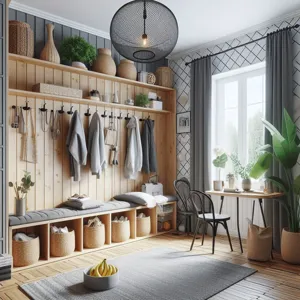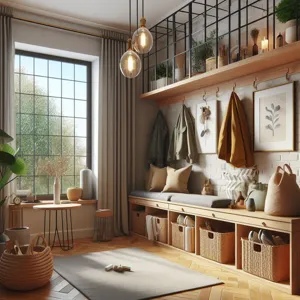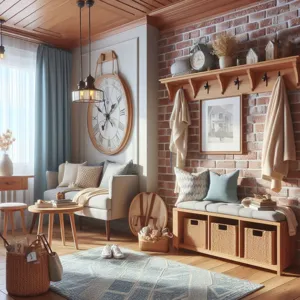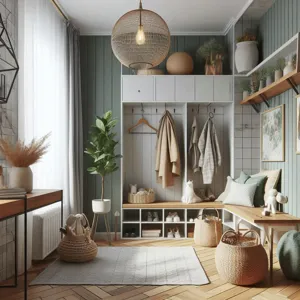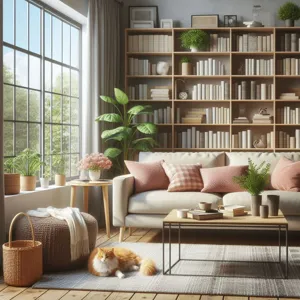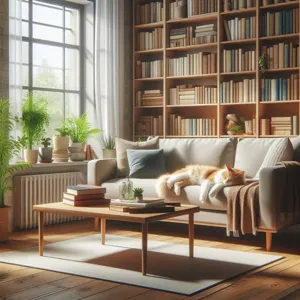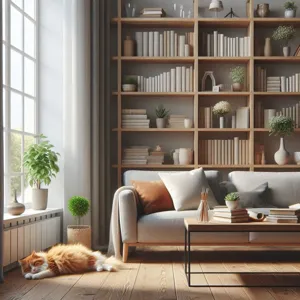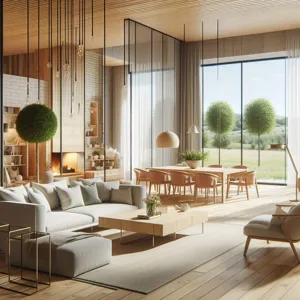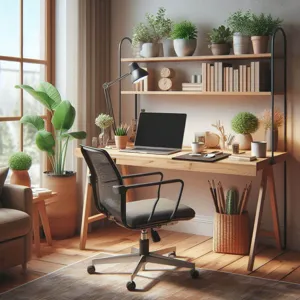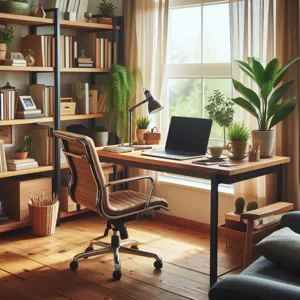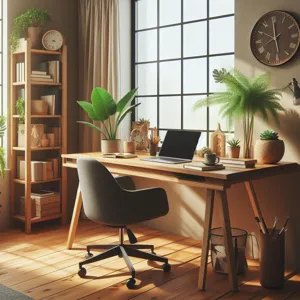As the seasons change and energy costs continue to rise, many homeowners find themselves searching for effective ways to cut down on their monthly bills.
The good news is that reducing your home energy expenses doesn’t have to involve major renovations or complicated systems. With just a few simple strategies, you can make a significant impact on your energy consumption and save money in the process. From optimizing your heating and cooling systems to embracing eco-friendly habits, these ten straightforward tips are designed to empower you to take control of your energy use. Join us as we explore practical solutions that not only enhance your home’s efficiency but also contribute to a more sustainable future, allowing you to enjoy comfort and savings year-round.
1. Understanding Your Energy Consumption

Understanding your energy consumption is the crucial first step in slashing those pesky home energy bills. Before implementing any changes, it’s essential to get a clear picture of how and where you’re using energy. This knowledge can empower you to make informed decisions that lead to significant savings.
Start by examining your energy bill, which can often feel like a cryptic puzzle. Break it down into its components: look for patterns in your usage over different months, identify peak periods, and note the costs associated with each category such as heating, cooling, lighting, and appliances. Many utility companies now offer detailed online portals where you can track your consumption in real-time. Utilize these tools to gain insights into your daily and monthly usage, allowing you to pinpoint energy hogs.
Next, consider conducting a home energy audit. This can be done professionally or even as a DIY project. Check for drafts around windows and doors, inspect insulation in your attic and walls, and assess the efficiency of your appliances. Simple tools like a thermal leak detector or even a candle can help you identify areas where air is escaping or entering your home unnecessarily.
Understanding how your habits contribute to your energy consumption is just as important. Do you leave lights on when you leave a room? Is your thermostat set higher than necessary? By tracking your daily habits and making small changes—like turning off lights or unplugging devices when not in use—you can make a significant impact on your overall energy usage.
With this foundational understanding in place, you can confidently move forward with targeted strategies to reduce your energy consumption and, ultimately, your monthly bills. By being proactive and informed, you’ll not only save money but also contribute to a more sustainable future.
2. Conducting a Home Energy Audit
A home energy audit is an essential step in understanding how much energy your home consumes and identifying opportunities for savings. Think of it as a health check-up for your house, where every nook and cranny is examined to determine where energy is being wasted. You can hire a professional auditor, or if you’re feeling adventurous, you might choose to conduct a DIY audit to start your journey toward energy efficiency.
Begin by inspecting your home for areas where air leaks may occur. Common culprits include windows, doors, and even electrical outlets. A simple test is to hold a lit candle or incense stick near these potential leak points; if the flame flickers or smoke shifts, you’ve found an area that needs attention. Additionally, check for gaps around ductwork and insulation in attics or basements, as these can significantly affect your heating and cooling efficiency.
Next, assess your appliances and lighting. Are you still using incandescent bulbs? Swapping them for energy-efficient LED alternatives can drastically reduce your energy consumption. Also, take stock of your appliances—those older models might be energy hogs compared to newer, more efficient versions. You can calculate their energy usage and consider upgrading when it makes financial sense.
Once you’ve compiled your findings, it’s time to prioritize improvements. Some changes may be simple and cost-effective, like sealing leaks or adding insulation, while others might require a larger investment, such as replacing older appliances. Regardless of the size of the changes, every bit counts. By conducting a home energy audit, you’ll gain valuable insights that empower you to make informed decisions and ultimately slash those pesky energy bills.
3. Insulating Your Home Effectively

Insulating your home effectively is one of the most impactful strategies you can employ to slash your energy bills. Proper insulation acts as a barrier, preventing the precious warmth generated by your heating system from escaping during the cold months and keeping the cool air inside during sweltering summer days. By ensuring that your home is well-insulated, you can significantly reduce the workload on your HVAC system, leading to lower energy consumption and, consequently, reduced utility costs.
Begin by evaluating the key areas in your home that are susceptible to heat loss or gain. The attic is often the first place to check, as heat rises and can easily escape through poorly insulated ceilings. Adding fiberglass batts or spray foam insulation can create an effective thermal barrier. Next, turn your attention to exterior walls, basements, and crawl spaces. These areas should be insulated with appropriate materials to prevent drafts and maintain a consistent indoor temperature.
Don’t overlook smaller gaps and cracks around windows and doors. Installing weather stripping or caulking can seal these openings, preventing air leaks that can contribute to energy loss. For existing windows, consider adding storm windows or thermal curtains to enhance insulation. Additionally, if you’re feeling adventurous, you might explore options such as blown-in cellulose insulation, which is environmentally friendly and can fill difficult-to-reach spaces.
By investing time and resources into insulating your home effectively, you not only enhance comfort throughout the year but also set yourself on a path to long-term savings. A well-insulated home is an energy-efficient home, and it’s a crucial step in your journey to slashing those pesky energy bills.
4. Sealing Drafts and Air Leaks
One of the simplest yet most effective ways to slash your home energy bills is by sealing drafts and air leaks. These sneaky gaps and cracks, often found around windows, doors, and even in your attic, can significantly undermine your heating and cooling efforts, leading to wasted energy and higher utility costs. Picture this: on a chilly winter evening, you crank up the thermostat to stay warm, but those icy drafts sneak in through poorly sealed areas, forcing your heating system to work overtime.
Start by conducting a thorough inspection of your home. Pay close attention to areas where two different building materials meet, such as the junction of walls and the ceiling, and look for any noticeable openings. A simple candle test can help you detect drafts—light a candle and move it around potential leak sources; if the flame flickers, you’ve found a draft. Common culprits include gaps around window frames, the edges of doors, electrical outlets, and even the spaces where pipes enter your walls.
Once you’ve identified problem areas, it’s time to take action. Caulk is your best friend for sealing small gaps, while weatherstripping can be applied to doors and windows to create a tight seal. For larger openings, such as those found in attics or basements, consider using foam insulation or expandable sealants. Not only will these measures help keep your home cozy in the winter and cool in the summer, but they will also lead to substantial savings on your energy bills.
In addition to immediate energy savings, sealing drafts contributes to the overall comfort of your home. No one wants to sit in a room that feels drafty or unevenly heated. By taking the time to seal those leaks, you enhance your living environment, making it more enjoyable for you and your family. Plus, the added benefit of reducing your carbon footprint makes this strategy a win-win. So, grab your caulk gun and weatherstripping, and start sealing those drafts today—your future self (and your wallet) will thank you!
5. Upgrading to Energy-Efficient Appliances

Upgrading to energy-efficient appliances can be a game changer for your household energy consumption and your wallet. The initial investment may seem daunting, but the long-term savings and environmental benefits make it a worthwhile endeavor. Energy-efficient appliances are designed to use less electricity and water without sacrificing performance, which means you can enjoy the same functionality and comfort in your home while reducing your energy bills.
When shopping for new appliances, look for the ENERGY STAR label, which signifies that the product meets strict energy efficiency guidelines set by the U.S. Environmental Protection Agency. These appliances can include everything from refrigerators, dishwashers, and washing machines to water heaters and air conditioning units. For example, an ENERGY STAR-certified refrigerator can use up to 15% less energy than its non-certified counterpart, translating to significant savings over time.
Additionally, upgrading your appliances can improve your home’s overall energy efficiency. Modern designs include features such as smart technology that allows you to monitor and control energy usage from your smartphone, as well as improved insulation and better temperature regulation. These advancements not only help you save on utility bills but also contribute to a more sustainable lifestyle.
Furthermore, many utility companies offer rebates or incentives for purchasing energy-efficient products, which can help offset the initial costs. By investing in energy-efficient appliances today, you’ll not only reduce your energy consumption but also increase the overall value of your home—making it a smart and sustainable choice for the future.
6. Utilizing Smart Thermostats
In an age where technology seamlessly integrates into our daily lives, utilizing smart thermostats is one of the most effective strategies to slash your home energy bills. These intelligent devices offer a level of control that traditional thermostats simply cannot match, allowing you to optimize your heating and cooling systems with ease.
Imagine walking into your home after a long day, greeted by a perfectly comfortable temperature—thanks to your smart thermostat’s ability to learn your preferences and adjust accordingly. These devices can track your habits and patterns, automatically adjusting the temperature when you’re away and ensuring your home is cozy when you return. Many models even allow you to set schedules for different times of the day, so you’re not heating or cooling an empty house.
One of the standout features of smart thermostats is their remote accessibility. With a simple tap on your smartphone, you can adjust the temperature, check energy usage reports, and even receive alerts if something seems amiss. This means you can save energy and money even when you’re not at home, eliminating the worry of accidentally leaving the heat on during a long vacation or forgetting to turn off the air conditioning when you leave for the day.
Additionally, many smart thermostats provide integration with other smart home devices, allowing you to create a cohesive energy-saving strategy throughout your home. For instance, you can sync your thermostat with smart blinds that close during the hottest parts of the day, reducing the need for cooling, or with motion sensors that adjust temperatures based on room occupancy.
Investing in a smart thermostat not only enhances your comfort but also empowers you to take control of your energy consumption. By making informed adjustments and utilizing automated features, you can significantly reduce your energy bills while contributing to a more sustainable future. It’s a small upgrade that can lead to big savings—both for your wallet and the environment.
7. Implementing Energy-Saving Lighting Solutions

When it comes to cutting down on home energy bills, one of the simplest yet most effective strategies is to implement energy-saving lighting solutions. The type of lighting you choose can have a profound impact on your energy consumption and consequently, your monthly expenses.
Begin by swapping out traditional incandescent bulbs for LED (Light Emitting Diode) bulbs. While the initial cost may be higher, LEDs use up to 75% less energy and last up to 25 times longer than their incandescent counterparts. This means you’ll not only save on energy costs but also reduce the frequency of replacements, making LEDs a smart investment in the long run.
In addition to switching to LEDs, consider utilizing smart lighting systems. These innovative solutions allow you to control your lighting remotely, adjust brightness, and even set schedules for when lights should turn on and off. For instance, you can program your outdoor lights to turn off at dawn and your indoor lights to come on at dusk, ensuring that lights are only used when necessary. Furthermore, motion sensor lights can be installed in areas such as hallways, bathrooms, and outdoor spaces, automatically turning on when someone enters and off when they leave.
Another effective strategy is to maximize natural light. open your curtains and blinds during the day to let sunlight illuminate your home, reducing the need for artificial lighting. Strategically placing mirrors can also help to reflect light and brighten up dark corners of your rooms.
Finally, don’t underestimate the power of a well-planned lighting layout. Evaluate your space and determine which areas require more light and which can be dimmer. By focusing your lighting in the most used areas and opting for ambient lighting instead of harsh overhead lights, you can create a cozy atmosphere while keeping energy consumption in check.
By implementing these energy-saving lighting solutions, you’ll not only lower your home energy bills but also create a more inviting and efficient living space.
8. Harnessing the Power of Natural Light
Harnessing the power of natural light is one of the simplest yet most effective strategies to reduce your home energy bills while simultaneously enhancing your living space. Natural light not only brightens up your home but also reduces the need for artificial lighting, which can significantly lower your electricity consumption.
Start by assessing your space; consider which rooms receive the most sunlight throughout the day. If possible, rearrange your furniture to maximize exposure to these sunlit areas, allowing light to flow freely into your home. Opt for lighter-colored walls and furnishings, as they reflect light and create a more open, airy feel, effectively amplifying the natural brightness.
Also, consider installing larger windows or glass doors that lead to outdoor spaces. If structural changes aren’t feasible, strategically placing mirrors can enhance natural light distribution, creating the illusion of a brighter and more spacious environment.
During the day, make it a habit to open curtains and blinds to invite the sunlight in, and only close them when the sun sets to trap warmth inside your home. In the cooler months, this natural heating can help reduce reliance on heating systems, further contributing to energy savings.
By embracing natural light, not only will you cut down on your energy bills, but you’ll also cultivate a healthier and more inviting atmosphere that fosters well-being and productivity. It’s a win-win strategy for both your wallet and your home!
9. Adjusting Heating and Cooling Practices
Adjusting your heating and cooling practices can lead to significant savings on your home energy bills while enhancing your comfort. One of the simplest yet most effective strategies is to invest in a programmable thermostat. By setting your thermostat to lower temperatures during the night or when you’re away from home, you can prevent unnecessary energy consumption without sacrificing comfort. For instance, if you lower your thermostat by just a few degrees in the winter, or raise it during the summer, you can reduce your energy bill by up to 10% annually.
Furthermore, consider the time of day you use your heating and cooling systems. Take advantage of natural ventilation: open windows during cooler parts of the day to let in fresh air, and close them during peak heat hours to keep your home cool. In the winter, allow sunlight to stream in through the windows during the day to warm your space naturally, and remember to close curtains or blinds at night to retain that warmth.
Regular maintenance of your HVAC system is also crucial. Schedule seasonal check-ups to ensure your heating and air conditioning units are running efficiently. Clean or replace air filters monthly, as clogged filters can restrict airflow and make your system work harder, leading to higher energy bills.
Lastly, don’t overlook the importance of zoning your home. If you have rooms that are rarely used, consider shutting vents or adjusting the heating and cooling settings in those areas. This way, you focus your energy use on the spaces that matter most, effectively slashing your bills without compromising your comfort. By making these simple adjustments to your heating and cooling practices, you can create a more energy-efficient home while keeping your costs in check.
10. Exploring Renewable Energy Options
As the world becomes increasingly aware of the need for sustainable practices, exploring renewable energy options has never been more relevant, especially for homeowners looking to slash energy bills. Transitioning to renewable energy sources not only contributes to a healthier planet but can also lead to significant long-term savings on your energy expenses.
Solar energy is one of the most popular and accessible forms of renewable energy for residential properties. By installing solar panels on your roof, you can harness the power of the sun to generate electricity for your home. Many regions offer incentives such as tax credits and rebates, which can offset the initial installation costs. Additionally, with advancements in technology, solar panels have become more efficient and affordable than ever.
Wind energy is another option to consider, particularly if you live in an area with consistent wind patterns. Small wind turbines can be installed on your property, allowing you to generate your own electricity. Although this option may require more space and a higher upfront investment, it can yield substantial savings over time.
Geothermal heating and cooling systems are also an exciting option, utilizing the earth’s stable underground temperature to regulate indoor climate. While the installation can be costly, the energy efficiency and reduced utility bills can make it a worthwhile investment in the long run.
Moreover, exploring community solar programs can be a viable choice for those who may not have the ability to install renewable energy systems on their property. These programs allow homeowners to purchase or lease a portion of a shared solar installation, providing the benefits of solar energy without the need for individual panel installation.
Ultimately, by exploring renewable energy options, you not only reduce your dependence on fossil fuels but also secure a more stable and predictable energy cost in the face of fluctuating utility rates. Embracing these sustainable solutions is not just an investment in your home, but an investment in our planet’s future.
11. Reducing Water Heating Costs
Reducing water heating costs is an often-overlooked but impactful strategy for slashing your home energy bills. Water heating typically accounts for a significant portion of your energy usage, and small adjustments can lead to substantial savings over time.
Start by checking the thermostat on your water heater. Most manufacturers set it to 140°F, but for most households, a setting of 120°F is sufficient for daily needs like showering, dishwashing, and laundry. Lowering the temperature not only reduces energy consumption but also minimizes scalding risks, making it a win-win for safety and savings.
Insulating your water heater and the first few feet of hot and cold water pipes can also prevent heat loss, ensuring that your water stays hot longer without requiring constant heating. Look for insulation blankets specifically designed for water heaters, which can be easily wrapped around the unit, or use pipe insulation for the exposed pipes.
Consider investing in a more energy-efficient water heater if your current model is older. Tankless water heaters provide hot water only when needed, eliminating standby heat loss and potentially saving you even more on your energy bills. If you have a traditional tank water heater, regular maintenance—such as flushing the tank to remove sediment buildup—can improve efficiency and prolong its lifespan.
Finally, be mindful of your water usage habits. Simple changes like taking shorter showers, fixing leaky faucets, and running dishwashers and washing machines only with full loads can significantly reduce hot water consumption, further cutting down on those pesky bills. By making these strategic adjustments, you’ll not only enjoy a more efficient home but also feel good about your contribution to energy conservation.
12. Using Power Strips and Smart Plugs
In the quest to reduce home energy bills, one of the simplest yet most effective strategies is the use of power strips and smart plugs. Often overlooked, these handy devices can significantly cut down on energy waste, especially in homes filled with electronics.
Power strips allow you to consolidate multiple devices into one convenient outlet, making it easier to turn off several appliances at once. Many people don’t realize that even when devices are turned off, they can still draw power—this phenomenon is known as “phantom load” or “vampire energy.” By plugging several devices into a power strip, you can easily disconnect them from the power source when they’re not in use, eliminating that unnecessary energy drain.
Smart plugs take this a step further, offering advanced features that allow you to control your devices remotely via smartphone apps. This means you can turn off lights, chargers, and other electronics from anywhere, ensuring that you never leave a device running when it shouldn’t be. Many smart plugs also come with scheduling capabilities, so you can set your devices to turn off automatically during peak energy hours or when you know you won’t be home.
Incorporating power strips and smart plugs into your daily routine not only simplifies your energy management but also empowers you to be more mindful of your energy consumption. By making a conscious effort to unplug devices and utilize technology to manage your energy use, you can enjoy a more efficient home and watch your energy bills shrink over time. Whether you’re a tech-savvy enthusiast or just starting your journey to a more energy-efficient lifestyle, these devices are a small investment that can lead to significant savings on your monthly bills.
13. Developing Energy-Conscious Habits
Developing energy-conscious habits is one of the most effective and sustainable ways to reduce your home energy bills. These habits may seem small at first, but over time, they can lead to significant savings and a lower carbon footprint. Start by being mindful of your daily routines and making simple adjustments that can add up.
For instance, consider the habit of turning off lights in rooms you’re not using. It’s a straightforward action, but one that many overlook in the hustle and bustle of daily life. Installing motion sensor lights in frequently used areas can also help automate this process, ensuring lights only illuminate when needed.
Adjusting your thermostat, even by a couple of degrees, can have a profound impact on energy consumption. In the winter, wearing a cozy sweater indoors and lowering the thermostat by just a few degrees can yield substantial savings. Similarly, in the summer, raising the thermostat slightly while using fans can keep your home comfortable without overworking your air conditioning system.
Another habit to adopt is unplugging electronics when they’re not in use. Many devices continue to draw power even when turned off, a phenomenon known as phantom load. By using power strips, you can easily switch off multiple devices at once, cutting unnecessary energy consumption.
Being energy-conscious also extends to how you use appliances. For example, wait until you have a full load before running the dishwasher or washing machine, and consider air-drying clothes whenever possible. These small shifts in mindset and behavior can lead to significant reductions in your energy bills.
Lastly, don’t forget about the power of natural light. During the day, open your curtains and blinds to let in sunlight, reducing the need for artificial lighting. This simple act not only brightens your space but also creates a warm, inviting atmosphere.
By cultivating these energy-conscious habits, you can create a more sustainable lifestyle while enjoying the added benefit of lower energy bills. With every small change, you contribute to a larger collective effort toward energy conservation and environmental responsibility.
14. Monitoring Your Energy Use Regularly
Monitoring your energy use regularly is one of the most effective strategies to keep your home energy bills in check. Just as you would track your spending to manage your finances, keeping a close eye on your energy consumption can reveal valuable insights into your habits and help you identify areas for improvement.
Start by using a smart energy monitor or a home energy management system that provides real-time data on your energy usage. These devices can break down your consumption by appliance or area, allowing you to pinpoint which devices are draining the most power. Some systems even send alerts when energy use spikes, so you can take immediate action to reduce unnecessary consumption.
For a more straightforward approach, review your energy bills each month. Look for patterns and fluctuations in usage that may correlate with specific activities or seasonal changes. For instance, if you notice a significant increase during summer months, it may be time to reevaluate your cooling strategies or invest in more energy-efficient cooling systems.
Moreover, consider keeping a log of daily energy usage, which can be particularly helpful if you’re trying to implement changes and see their impact over time. Track the times of day when your usage is highest and experiment with different habits, such as turning off lights in unoccupied rooms or unplugging devices that consume energy even when not in use.
By regularly monitoring your energy use, not only will you become more conscious of your consumption habits, but you’ll also empower yourself to make informed decisions that lead to significant savings on your energy bills. With a little diligence, you can turn energy awareness into actionable strategies that promote both efficiency and sustainability in your home.
15. Taking Advantage of Utility Rebates and Incentives
Taking advantage of utility rebates and incentives is a savvy way to reduce your home energy bills while also contributing to a more sustainable future. Many utility companies and government programs offer financial incentives designed to encourage homeowners to adopt energy-efficient practices and technologies. These rebates can significantly offset the costs of various energy-saving upgrades, making them more accessible and affordable.
Start by researching the available programs in your area. Check your local utility company’s website, as they often provide detailed information on current rebates for energy-efficient appliances, insulation improvements, smart thermostats, and renewable energy installations like solar panels. You might be surprised at how many opportunities are available right at your fingertips.
For instance, upgrading to Energy Star-rated appliances can lead to substantial savings, and many utility providers offer cash back for purchasing these energy-efficient models. Similarly, if you’re considering solar energy, federal and state tax credits can make the initial investment much more palatable.
Don’t overlook the potential for incentives related to home energy audits, which can pinpoint areas where your home is losing energy. Some utility companies even provide free or discounted audits to help identify opportunities for savings.
Finally, staying informed about these programs is essential, as they can change frequently. Sign up for newsletters or alerts from your utility provider to ensure you’re always aware of the latest offerings. By proactively seeking out and utilizing these rebates and incentives, you can make energy-efficient upgrades that not only lower your bills but also enhance the comfort and value of your home.
As we wrap up our exploration of the 10 simple strategies to slash your home energy bills, we hope you feel empowered and inspired to take action. By implementing these practical tips, from optimizing your heating and cooling systems to embracing energy-efficient appliances, you can create a more sustainable living environment while saving money in the process. Remember, even small changes can lead to significant savings over time, benefiting both your wallet and the planet. We encourage you to start with one or two strategies today and gradually build upon them. Here’s to a more energy-efficient home and a brighter, greener future! If you have any tips of your own or success stories to share, we’d love to hear them in the comments below!









